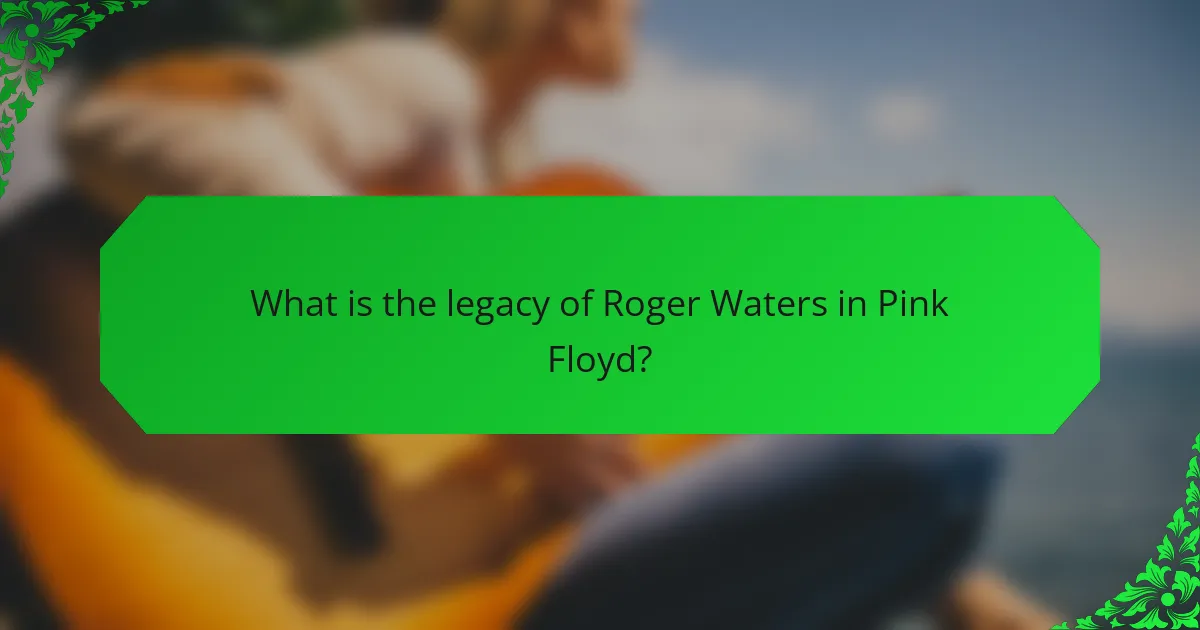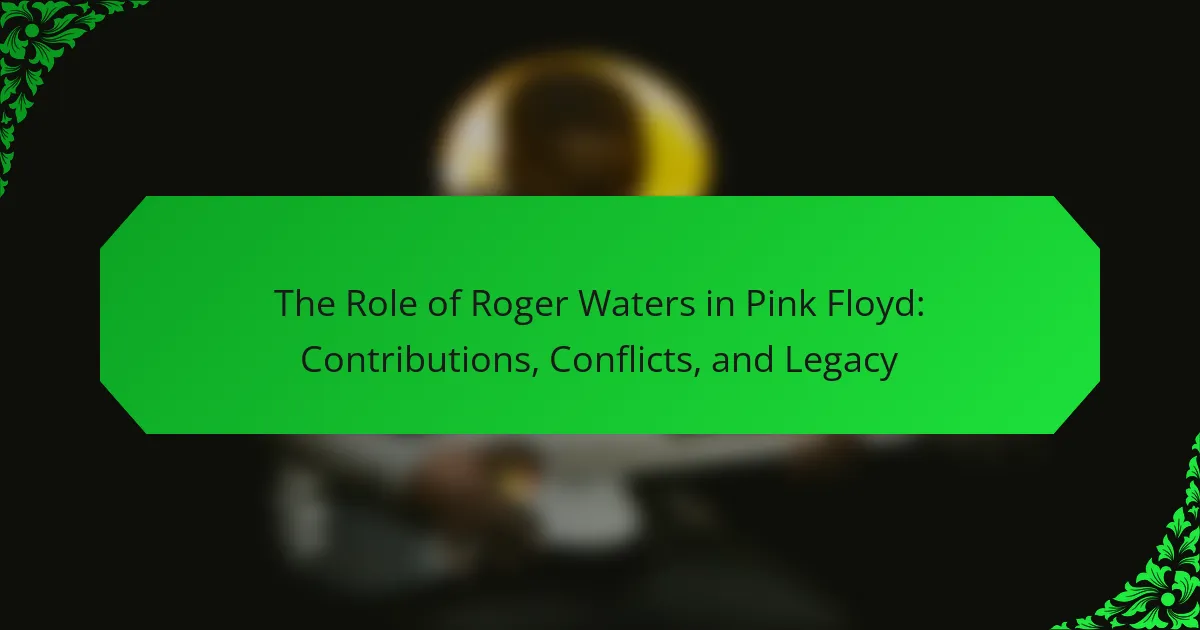Roger Waters was the bassist and primary lyricist for the rock band Pink Floyd, significantly influencing their musical direction from 1965 until his departure in 1985. His contributions include writing acclaimed albums such as “The Dark Side of the Moon,” “The Wall,” and “Animals,” which explore themes of alienation, societal issues, and existentialism. Waters’ role as the band’s creative leader during the 1970s introduced innovative concepts like rock operas and elaborate stage productions. The conflicts arising from his strong vision highlight the complexities of collaboration in artistic endeavors, ultimately shaping Pink Floyd’s identity and legacy in the music industry.

What was Roger Waters’ role in Pink Floyd?
Roger Waters was the bassist and primary lyricist for Pink Floyd. He joined the band in 1965 and significantly shaped their musical direction. Waters contributed to the writing of many of the band’s most acclaimed albums. His work includes conceptual themes and narratives, particularly in albums like “The Wall” and “Animals.” He became the band’s creative leader during the 1970s. His lyrics often explored themes of alienation and societal issues. Waters’ vision was central to the band’s identity during this period. His departure in 1985 marked a significant turning point for Pink Floyd.
How did Roger Waters contribute to Pink Floyd’s musical direction?
Roger Waters significantly shaped Pink Floyd’s musical direction through his songwriting and conceptual vision. He wrote many of the band’s most iconic songs, including “The Wall” and “Wish You Were Here.” Waters’ lyrics often explored themes of alienation, war, and human experience. His emphasis on storytelling in albums transformed the band’s music into a more cohesive narrative form. He also influenced the band’s sound by incorporating orchestral elements and experimental techniques. His leadership during the recording of “The Dark Side of the Moon” helped establish the band’s signature sound. Waters’ contributions solidified Pink Floyd’s status as pioneers of progressive rock. His departure in 1985 marked a significant shift in the band’s musical approach.
What specific albums did Waters influence the most?
Roger Waters influenced several specific albums significantly. “The Dark Side of the Moon” reflects his lyrical themes and conceptual approach. “Wish You Were Here” showcases Waters’ introspective songwriting style. “Animals” presents his political commentary, a hallmark of his influence. “The Wall” is perhaps the most notable, as Waters wrote and conceptualized the entire project. Each album features his unique vision, which shaped Pink Floyd’s identity. Waters’ influence on these albums is evident in their enduring popularity and critical acclaim.
How did his songwriting shape the band’s identity?
Roger Waters’ songwriting significantly shaped Pink Floyd’s identity. His lyrics often explored themes of alienation, war, and human experience. This focus created a deep emotional connection with the audience. Waters’ narrative style added a conceptual depth to the band’s music. Albums like “The Wall” and “Animals” exemplified this complexity. His ability to blend personal and political themes became a hallmark of the band’s sound. The band’s distinct identity emerged from Waters’ thought-provoking storytelling. His influence established Pink Floyd as a pioneering force in progressive rock.
What conflicts arose between Roger Waters and other band members?
Roger Waters experienced significant conflicts with other Pink Floyd members, particularly with David Gilmour and Richard Wright. These disputes often centered around creative control and artistic direction. Waters sought to dominate the band’s vision, leading to tension during the recording of “The Wall.” Gilmour and Wright felt marginalized by Waters’ approach. This conflict escalated after the band’s 1979 tour, resulting in Wright’s departure from the group. In 1985, Waters left Pink Floyd, citing irreconcilable differences with Gilmour. The disagreements were marked by public disputes, including legal battles over the band’s name and legacy.
What were the key disagreements that defined Waters’ tenure?
Roger Waters’ tenure in Pink Floyd was defined by key disagreements primarily over creative direction and control. Waters advocated for a more political and conceptual approach to music. This contrasted with other band members who favored a more commercial sound. Disputes arose over the thematic content of albums, particularly during the production of “The Wall.” Waters’ desire for artistic expression often clashed with the band’s need for cohesion. Tensions escalated during the recording of “Animals” and “The Final Cut.” These disagreements ultimately led to Waters’ departure from the band in 1985. The conflicts highlighted differing visions for Pink Floyd’s future.
How did these conflicts impact the band’s dynamics?
Conflicts within Pink Floyd significantly altered the band’s dynamics. Tensions, particularly between Roger Waters and other members, created an atmosphere of discord. This discord led to a decline in collaboration and increased isolation among band members. For instance, the creation of “The Wall” underscored Waters’ dominance in songwriting. His vision often overshadowed contributions from others, notably David Gilmour. As a result, Gilmour and others felt marginalized, impacting their creative input. The culmination of these conflicts ultimately contributed to the band’s breakup in the 1980s. Thus, internal strife shifted the band’s collaborative spirit to a more competitive and fragmented environment.

What is the legacy of Roger Waters in Pink Floyd?
Roger Waters’ legacy in Pink Floyd is profound and multifaceted. He was a primary songwriter and conceptual architect of the band’s most acclaimed albums. Waters’ themes often explored existentialism, mental health, and societal issues. His work on “The Dark Side of the Moon” and “The Wall” cemented the band’s status in rock history. Waters’ lyrics and narratives shaped the band’s identity and artistic direction. He introduced innovative concepts like rock operas and elaborate stage productions. His departure from the band in 1985 led to significant changes in Pink Floyd’s sound and dynamics. Waters’ influence continues to resonate in contemporary music and culture.
How has Waters’ influence persisted after leaving the band?
Roger Waters’ influence has persisted through his solo music and thematic content. After leaving Pink Floyd in 1985, Waters continued to explore complex themes in his work. His albums, such as “Amused to Death” and “Is This the Life We Really Want?”, reflect his critical views on society and politics. Waters’ live performances often incorporate elaborate theatrical elements. These performances resonate with audiences and maintain his relevance in contemporary music. Additionally, his commentary on social issues keeps his voice prominent in discussions about music and culture. Waters’ continued engagement with fans through social media also amplifies his influence. Overall, his artistic vision and activism ensure his legacy remains significant.
What themes from his work continue to resonate with fans?
Themes from Roger Waters’ work that continue to resonate with fans include alienation, war, and personal introspection. His exploration of alienation reflects the struggles of individuals in society. This theme is prominently featured in “The Wall,” which addresses feelings of isolation and disconnection. The theme of war is evident in works like “Animals” and “The Final Cut,” critiquing the impact of conflict on humanity. Personal introspection is a recurring element, showcasing Waters’ reflections on his own life experiences. These themes resonate due to their emotional depth and universal relevance. Fans connect with the authenticity and vulnerability expressed in his lyrics. Waters’ ability to tackle complex issues continues to engage audiences across generations.
In what ways has Waters’ solo career reflected his time with Pink Floyd?
Roger Waters’ solo career has reflected his time with Pink Floyd through thematic continuity and musical style. His lyrics often explore similar existential and political themes, evident in albums like “The Pros and Cons of Hitch Hiking.” Waters also employs a theatrical approach in his live performances, reminiscent of Pink Floyd’s elaborate shows. The use of conceptual storytelling is another hallmark, as seen in “Amused to Death,” which mirrors the narrative depth of Pink Floyd’s works. Additionally, his focus on personal and societal issues continues the band’s legacy of addressing profound topics. Waters’ distinctive bass playing and vocal style remain consistent, linking his solo work to his contributions in Pink Floyd.
Why is Roger Waters considered a controversial figure in music?
Roger Waters is considered a controversial figure in music due to his outspoken political views and provocative statements. His criticism of various governments and institutions has sparked significant debate. Waters’ comments on Israel and Palestine have drawn accusations of anti-Semitism from some critics. His theatrical performances often include politically charged imagery, which can polarize audiences. Additionally, his public disputes with former band members, particularly David Gilmour, have added to his controversial reputation. Waters’ approach to music and performance challenges societal norms, making him a divisive figure in contemporary music.
What are some notable controversies associated with Waters?
Roger Waters has been involved in several notable controversies throughout his career. One significant controversy revolves around his criticisms of Israel. Waters has been vocal about his support for the Boycott, Divestment, Sanctions (BDS) movement against Israel. This stance has led to accusations of antisemitism from various groups and individuals.
Another controversy stems from his public disputes with former bandmates, particularly David Gilmour. Tensions between Waters and Gilmour have been well-documented, leading to a fractious relationship that continues to attract media attention.
Additionally, Waters faced backlash for his theatrical performances, which sometimes include politically charged imagery. For instance, his use of a pig balloon adorned with symbols associated with various political ideologies has sparked debate and criticism.
Waters has also been criticized for his comments on various political figures. His statements about U.S. politics and leaders have generated mixed reactions from fans and critics alike.
These controversies illustrate the polarizing nature of Waters’ views and artistic expression. They reflect his commitment to political activism, which often intersects with his music and public persona.
How have these controversies affected public perception of his contributions?
Controversies surrounding Roger Waters have significantly impacted public perception of his contributions to Pink Floyd. Many fans admire his artistic vision and lyrical depth. However, some controversies have led to polarized views. Criticism of his political statements has alienated certain audiences. This has resulted in a decline in his popularity among specific demographic groups. Conversely, loyal fans continue to celebrate his creative influence. Public opinion often reflects a divide between appreciation for his music and disapproval of his views. Overall, these controversies have complicated his legacy within the music community.

What lessons can be learned from Roger Waters’ experience in Pink Floyd?
Roger Waters’ experience in Pink Floyd teaches valuable lessons about artistic integrity and collaboration. Waters prioritized his vision, leading to creative breakthroughs. However, his strong opinions often resulted in conflicts with band members. These disputes highlight the importance of balancing individual expression with group dynamics. The eventual split of Pink Floyd underscores how unresolved tensions can impact relationships. Waters’ journey emphasizes the need for effective communication in creative partnerships. His legacy shows that passion can drive innovation but may also lead to division. Ultimately, the story of Waters in Pink Floyd illustrates the complexities of collaboration in the arts.
What strategies can musicians adopt from Waters’ approach to creativity?
Musicians can adopt several strategies from Roger Waters’ approach to creativity. First, they can embrace conceptual storytelling in their music. Waters often used narratives to convey deeper themes. Second, musicians should prioritize collaboration while maintaining their artistic vision. Waters collaborated with band members but ensured his ideas were central. Third, they can experiment with different musical styles and genres. Waters incorporated various influences into Pink Floyd’s work. Fourth, musicians should engage with social and political issues through their art. Waters frequently addressed these themes in his lyrics. Lastly, they can focus on creating immersive experiences for their audience. Waters aimed to combine music with visual art in performances. These strategies reflect Waters’ innovative and impactful creative process.
How can artists navigate conflicts within a collaborative environment?
Artists can navigate conflicts within a collaborative environment by fostering open communication. They should actively listen to each other’s perspectives. Establishing clear roles and responsibilities can prevent misunderstandings. Setting common goals aligns the group’s vision. Utilizing conflict resolution techniques, such as mediation, can help address disputes. Regular check-ins can ensure everyone feels heard and valued. Encouraging a culture of respect promotes positive interactions. These strategies are vital for maintaining a harmonious collaborative atmosphere.
What best practices can be derived from Waters’ songwriting techniques?
Waters’ songwriting techniques emphasize narrative depth and emotional resonance. He often integrates personal experiences into his lyrics, enhancing authenticity. Waters utilizes vivid imagery to evoke strong visual connections in his songs. He frequently employs thematic concepts, such as alienation and societal critique, to engage listeners intellectually. Waters also demonstrates the power of collaboration, working closely with other band members to refine ideas. His use of varied musical structures keeps compositions dynamic and interesting. Waters’ focus on social and political issues provides relevance and context to his work. These practices contribute to creating impactful and memorable music.
The main entity of the article is Roger Waters, the bassist and primary lyricist for Pink Floyd. The article examines Waters’ significant contributions to the band’s musical direction, including his role in shaping iconic albums such as “The Wall,” “Animals,” and “The Dark Side of the Moon.” It also explores the conflicts between Waters and other band members, particularly regarding creative control, and how these tensions impacted the band’s dynamics. Additionally, the article discusses Waters’ legacy, his continued influence in music and culture, and the lessons that can be learned from his experiences within the band.
